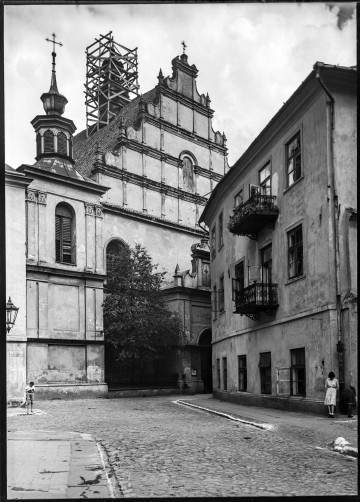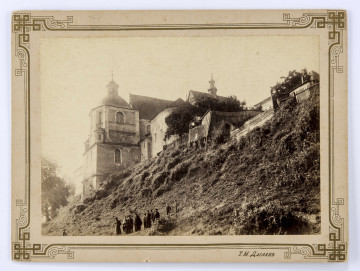
Dominican Church
1931
National Museum in Lublin
Part of the collection: Lubliniana. Painting views of Lublin and the Lublin Region (17th–early 20th c.)
The figure depicts a fragment of the Tree of the Crucifixion of Jesus Christ (the Cross), a priceless Lublin relic kept in the Lublin Dominican church from 1333 or 1420, until it was stolen in 1991. The relic is presented without a rim, with scratches, and with a particularly noticeable crack. The life-size drawing shows its shape: an isosceles cross with rounded shoulders.
The tree of the Crucifixion of Jesus Christ in the form of relics has been worshipped since the 4th century CE as the most important instrument of the Lord’s Passion. The cross on which Christ died was found at Golgotha on September 14th, 320 CE, owing to St. Helena, mother of Emperor Constantine the Great. It is known that already before 348 CE it was divided into small relics for ‘the whole world’ and sent to the surrounding churches. The largest parts were left in Jerusalem and placed in Hagia Sophia in Constantinople and in the Basilica of Santa Croce in Gerusalemme in Rome, the main centres of Christianity. Currently, the largest part of the relic is in Brussels, in the church of St. Gudula. In Poland, large fragments of the Tree were in hands of, among others, the Dominican Church in Lublin, the Holy Cross on Łysa Góra and the Świętokrzyska Chapel at Wawel. According to research from 1870, the relic of Lublin was the second largest in the world in terms of size (later findings put it in the third place) and was the largest in Poland. It came to Lublin from Kiev, where it had been kept since 988, when it was brought to Rus from Constantinople by Anna, a Byzantine princess married to the Prince of Kiev, Vladimir.
Through the Dominican relic, many supernatural events took place in Lublin, including the salvation of the city from the Cossacks in 1648, as evidenced by written and iconographic sources. Many generations of Lublin residents and pilgrims prayed in front of this ‘Tree, holy beyond everything’, convinced that it was ‘a treasure of God’s graces’, experiencing numerous graces and healings. It was believed that the relic had miraculous power, as every part of the Cross was touched with the blood and sweat of Christ, and bore the traces of his Passion. The relic was venerated with especial fervour, and the Dominican church building, along with Jasna Góra and the Corpus Christi Church in Poznań, became an important Polish sanctuary, the largest one in the 16th century.
Renata Bartnik
Author / creator
Dimensions
cały obiekt: height: 31,5 cm, width: 31 cm
Object type
graphics
Technique
woodcut
Material
laid paper
Creation time / dating
Creation / finding place
Owner
The National Museum in Lublin
Identification number
Location / status

1931
National Museum in Lublin

1890 — 1910
National Museum in Lublin

1918 — 1919
National Museum in Lublin
DISCOVER this TOPIC
Castle Museum in Łańcut
DISCOVER this PATH
Educational path